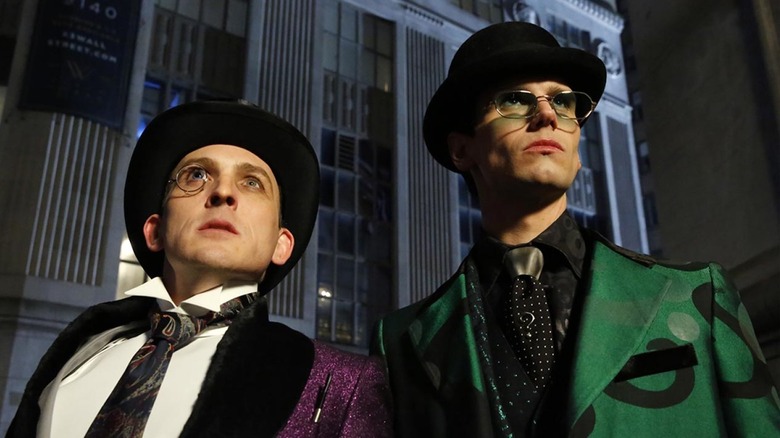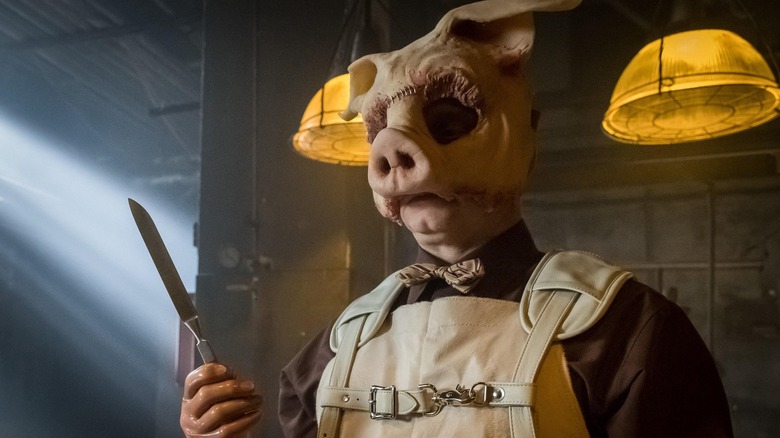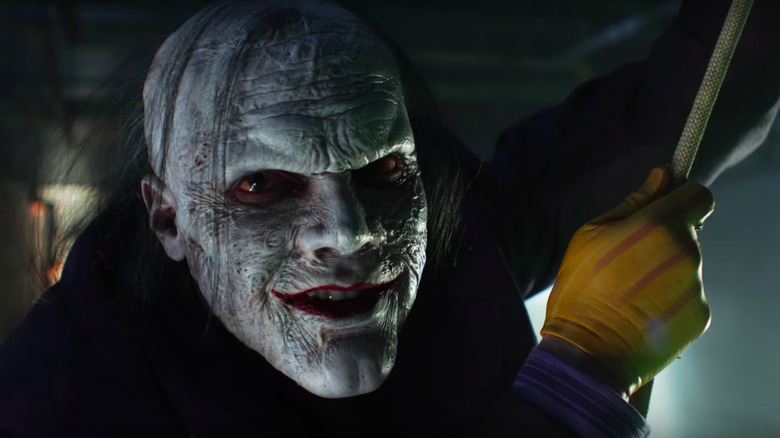The Daily Stream: Gotham Shows That Batman Can Be Very Silly And Still Work
(Welcome to The Daily Stream, an ongoing series in which the /Film team shares what they've been watching, why it's worth checking out, and where you can stream it.)
The Series: "Gotham"
Where You Can Stream It: Netflix
The Pitch: With "The Batman" hitting theaters, giving us a new take on iconic characters and locations, I got a Bat-fever. Many folks will probably quench their thirst for more Bat-stories by rewatching the Nolan trilogy, or Ben Affleck's brief tenure as the character, or even watching the delightful 1966 "Batman" show. But there was another Batman-related project which instantly came to mind after I watched the Matt Reeves movie and his bonkers, funny take on emo Batman: "Gotham."
Back in 2014, "Gotham" premiered as the Batman equivalent of "Smallville," a prequel series telling the story of how Bruce Wayne becomes Batman, but this time focusing on James Gordon's early days as a cop with the Gotham City Police Department in the aftermath of the murder of one Thomas and Martha Wayne.
Far removed from the campy fun of the 1966 series or the soap opera-like Arrowverse shows, "Gotham" started out like a hard-boiled adaptation of the acclaimed comic "Gotham Central" or a "Law & Order" like show set in Gotham City, constantly winking at the audience to make sure they were aware these characters would one day become iconic Batman characters.
And then, the show took a page out of the "Legend of Tomorrow" book and threw logic out the window to embrace its chaos.
Why it's essential viewing
Already in its third episode, it was clear that "Gotham" had more on its mind than just being a police procedural with some comic book references. That episode follows a serial killer who attaches his victims to weather balloons to see them fly away and then drop from the sky. The show started to quickly remove its one foot set in the world of procedural dramas and move it over to the silliest and most bonkers of comics.
Nowhere is this more evident than in the show's treatment of its villains. Outside of original characters like the aforementioned Balloonman, or more famous villains like Poison Ivy, Penguin, and Riddler, the show also shone a light on lesser-known Batman villains like Hugo Strange, Firefly, Victor Zsasz (played to darkly comedic perfection by "Barry" star Anthony Carrigan), to Professor Pyg and Mat Hatter, a man obsessed with Lewis Carroll.
At a time when "Arrow" was afraid to even mention the name Green Arrow or have its main character wear a bright green costume and sport a goatee, "Gotham" said screw logic and turned a mob henchman into literal zombie Solomon Grundy. At its best, the show embraced the weird, malleable logic of comic books and painted a pastel-colored nightmare on the streets of Gotham with scenes like Professor Pyg singing a happy tune while feeding some rich people meat pies made out of poor people. We even got not one, but multiple evil twin storylines in the show, and also a don't-call-him-Joker clown-themed villain who got his face peeled off. By the time the fifth season covered "No Man's Land," it also brought along Frank Miller-style mutants; I'd love to see the Arrowverse or the Disney+ shows try that!
Likewise, "Gotham" avoids a problem common with many modern superhero adaptations (especially TV ones): wanting to wait out before adapting the better-known characters or storylines.
Even if Bruce Wayne is not even old enough to vote, "Gotham" adapts many famous Batman storylines without the need for the Caped Crusader, from "The Court of Owls," to "Hush," to "Knightfall," "Death of the Family," and "No Man's Land" — and it works. The big question "Gotham" had to answer when it premiered was how you do a Batman show without Batman? How do you justify having all these villains already in costume before Bruce ever puts on the cowl? By the time the finale aired, it gave a very compelling answer. After five seasons, "Gotham" had put its titular city through so much hell, terrorized by so many crazy villains, that the only logical solution to the city's problems is for a rich kid to dress up as a bat and punch them in the face.
'Madness is the emergency exit'
Arguably the biggest contribution "Gotham" made to the Batman mythos, and the thing that made it stand apart from other superhero shows was its introduction of the Valeska brothers — Jerome and Jeremiah.
First introduced as a circus worker, Jerome quickly became the leader of a gang, wreaking havoc in Gotham. The show managed to run through a collection of greatest Joker hits, introducing everything from his laughing toxin, to a cult devoted to him, to recreations of scenes from "The Killing Joke," "Under the Red Hood," the face-removal plot point from "Death of the Family" and more. We even got a proto-Harley Quinn that was completely devoted to Jerome.
And when that wasn't enough, "Gotham" killed off Jerome (in a nice reference to the 1989 "Batman") and brought in another not-Joker, Jerome's identical twin brother Jeremiah. Where you can imagine the creative minds behind most movie adaptations of comics agonizing over the decision of which side of a major character like Joker to adapt — the clown prince? Psychopathic killer? Dapper mastermind? — "Gotham" doesn't have that problem. If Jerome was the maniacal anarchist, part Heath Ledger, part Grand Morrison, part Scott Snyder's take, then Jeremiah was old-school Joker, part Jack Nicholson and part Cesar Romero, a criminal mastermind with pale skin and a liking of purple suits that Batman can never anticipate or properly catch. He even gets thrown into a vat of chemicals at the end!
Now that "The Batman" proved that the Bat-movies can actually look and feel like comic book movies again, it's time to revisit the series that showed you can follow bonkers comic book logic and it would not hurt, but actually enhance the viewing experience.


